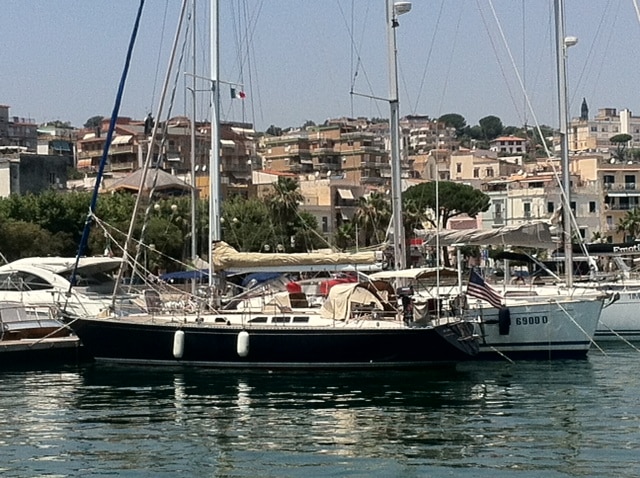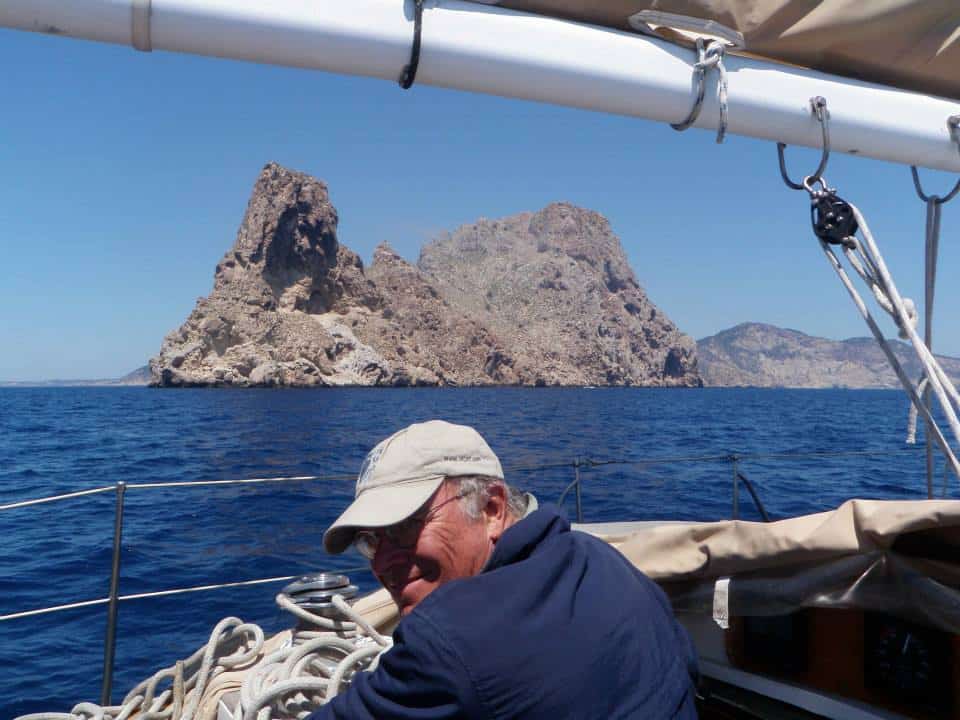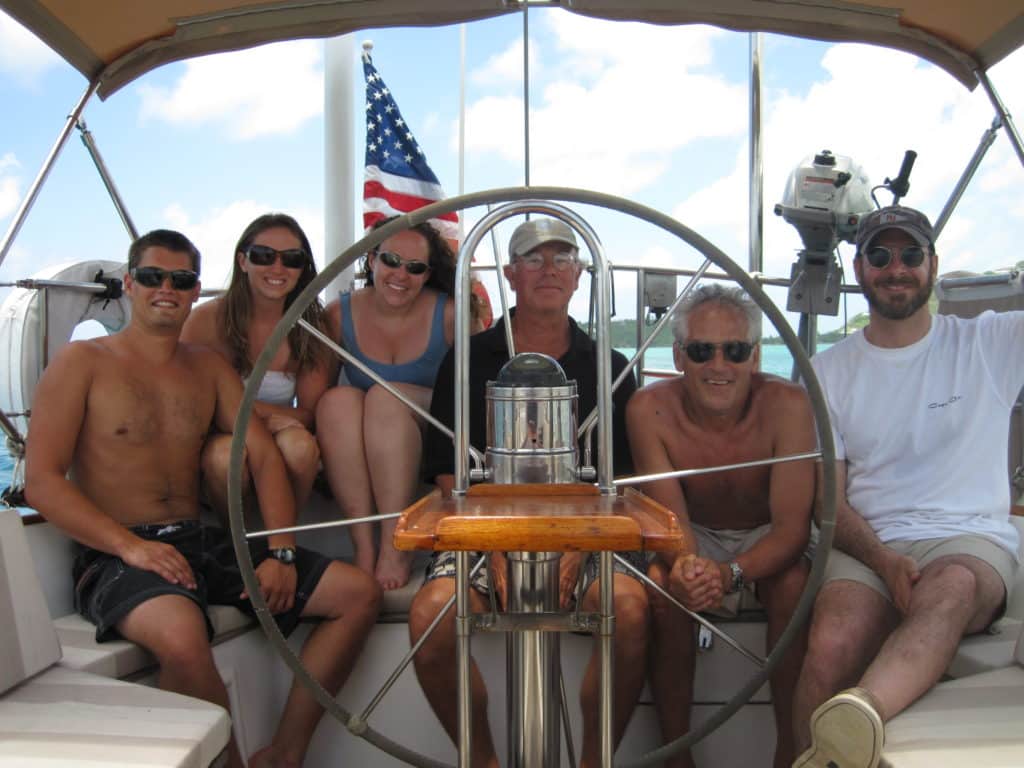
When I first started thinking about long-distance cruising, back in the 1960s, there weren’t many role models. Eric and Susan Hiscock were sailing around the world, just the two of them in their modest wooden boats, gone for a few years at a time. They chronicled their travels in books, magazine articles and films, and were soon followed by Lin and Larry Pardey. On the West Coast, countercultural adventurers were building Piver trimarans in their backyards to sail west across the Pacific. But for me, in practical terms, all these voyagers were hard to relate to.
These cruisers, or their descendants, are still out there, and you can find them at ocean crossroads like the Azores, the Caribbean and French Polynesia, among many other distant ports. But as voyaging evolved and became more popular, the full-time commitment exemplified by the Hiscocks and Pardeys also changed. Many aspiring cruisers instead opted for a different plan: saving some money, waiting until the kids were grown, renting their house and buying a dedicated ocean cruising boat — all the time thinking that in three to five years, they’d sell it, move back ashore and downsize to a smaller boat. I thought that as soon as I had enough money and time, I’d do something similar. But both money and time had a way of slipping away. And what if you can’t leave your job or friends and family for a few years — or simply don’t want to — but you still have the wanderlust?
For the past 10 years, the answer for me has been to commute to my boat, already docked in some faraway destination, two to three times per year. A Boeing 737 is my dinghy. Most of my trips take around five weeks, including travel time. It’s long enough to sail across an ocean, island-hop in the Caribbean or skip from port to port in the Mediterranean, and yet short enough to maintain ties with home and work. For me, it’s the best of both worlds.
It started in 2004, when I was itching to sail across the Atlantic to Europe. I’d cruised much of the West Coast and the East Coast as far north as Labrador, and had made nine passages between New England and Bermuda, mostly delivering boats from the Newport-Bermuda Race. But Bermuda trips take only five to seven days, and I wanted the experience of being away from land long enough to be immersed in the sea, neither leaving nor arriving anyplace too soon, but becoming one with the ocean. I reckoned a five-week journey from Maine to the Azores aboard Nottoway, my Bristol 39, would do the trick. I budgeted a week to get ready, two weeks plus for the crossing, and a week to 10 days to see the Azores and prepare the boat to winter in Horta. And it all worked according to plan. Setting off in July, I had a memorable trip and then left the boat at Horta’s Mid Atlantic Yacht Services, returning in August to home and work.
That winter I flew back to Horta for some boat work, and to kibitz with the boatyard about the new centerboard being built to replace the one that had broken off halfway across the Atlantic. At that time of year, the Azores is a dramatic and storm-tossed destination with an “edge of the world” feeling. My 10-day vacation was a welcome winter break. Plus, any yacht that gets to the Azores has crossed at least a thousand miles of open ocean, so the assembled fleet represents a floating case study of ocean cruisers. It was cool checking them out.
Around that time, I decided not to sail home the following summer, but to keep heading east. So, in the spring of 2005, I returned to Horta with an experienced offshore crew to sail from there to Lisbon, where we would swap the ocean sailors for coastal cruisers. As it turned out, we never made it to Lisbon; the northeasterly Portuguese trades were far too strong.
Heaved-to less than a hundred miles from Lisbon, we called the waiting coastal crew on the sat phone and told them, midgale, that according to the cruising guide there was a marina to the south, in Lagos, and they should take the train there to rendezvous. The Lagos train station was virtually in the marina, and it all worked like a charm. After arriving in Lagos, we happily cruised the coasts of Portugal and Spain for a couple of years, twice in the summer with brief working vacations in the intervening winters. We’ve followed a similar routine ever since.
After those first winters in Horta and Lagos, in the years that followed I left Nottoway in the Spanish ports of Cadiz, Almeria and Torrevieja, and in Menorca in the Balearic Islands, where I sold her in 2009. A year later, in Martinique, I purchased Scarlet, an Alan Warwick-designed Cardinal 46, and we started all over again.
Between cruises throughout much of the Caribbean, we left Scarlet for extended periods in Martinique, Antigua and Tortola. Then it was on to Bermuda and more winters in the Azores and Lagos. From there we harbor-hopped to Tangier, Morocco, and onward to the Balearics, wintering over in Santa Eulalia, Ibiza. The next jump was to Menorca, Corsica and Sardinia, and onward to Gaeta, Italy, near Naples. Between sailing trips, I continued to return to my rental house in Kittery, Maine (which the owners use during the summer), and to my publishing business.
This commuter cruising was born of necessity: I couldn’t run my business from my boat, and I need to work directly with my ever-patient business partner. She’s a sailor too, so she understands. Mostly. So far, six weeks away seems to be about my maximum time limit. After that, it’s asking too much of the people in the office. And they have pointed that out!
In fact, even if I didn’t have business commitments, I would still want to return home at least two or three times a year to see friends and family and wash the salt off. Many long-distance cruisers, I’m discovering, enjoy the same schedule.
While I sail with the ghosts of the Hiscocks, the Smeetons and other great sailing voyagers of my youth, in practice I’m totally 21st-century. Air travel is easy, email is great, and work and home don’t need to be abandoned. Commuter cruising has a lot to offer.
Before you go take up commuter cruising, ask yourself these four very important questions.

1. The Cost-Conscious Commuter
Make no mistake: This is an expensive way to go cruising. Three long round-trip plane flights per year, plus the attendant travel expenses, is a substantial outlay. What has been surprising, to me at least, is that in head-to-head comparisons of marina and yard rates in Antigua, West Indies; Martinique; Horta, Azores; Lagos, Portugal; Gaeta, Italy; and the Connecticut shoreline of eastern Long Island Sound, the cost of leaving a boat in the Caribbean or southern Europe is not very different from keeping a boat in a similar facility in the Northeastern United States.
An unquantifiable cost of cruising far from home and outside of the English-speaking world is that it is harder to find bargains; plus, useful information about costs and services is difficult to assess. “Local knowledge” can be hard to interpret. What locals might consider a reasonably priced marina in France may seem eye-popping to an American cruising there in the August high season.
Of the places listed above, cost-conscious sailors will find better deals in the Caribbean and Azores. Less fashionable places tend to be less expensive. In the Balearic Islands, the port of Mahon, Menorca, is less expensive than jet-setting Palma de Mallorca. (And if you’re a fan of Patrick O’Brian’s Captain Aubrey and Maturin books, you need to go to Mahon anyway.)
And some things are just more expensive outside the U.S., including parts, fuel and service. In Europe, pressure washing and bottom painting can be as much as three times what the same jobs will cost stateside. Labor rates are similar across Europe but can be lower in the Caribbean.
When you leave your boat to return home, it will have to be hauled and stored, or docked in a rental slip with someone paid to watch over it. That’s either three haulings and launchings per year (rather than the usual one), or the expense of a long-term caretaker while it’s afloat. (That said, local yacht brokers make good boat watchers. They are often around the docks. I instruct them, “Watch the lines: the dock lines and the waterline. When in doubt, call me.”) Finally, boat work that you might do yourself at home will often be done by boatyards, which adds to the cost.

2. Choosing Destinations for Layovers
I believe in planning, but when it comes to commuter cruising, I think a better skill is being adaptable. We set a destination with the full knowledge that some version of Plan B is a likely result. In the process of researching a cruise, I identify boatyards or marinas that seem like possible choices for a layover. Some of the factors I consider are cost, proximity to airports, marina facilities and my general interest in the locale.
Researching a specific marina or boatyard is not easy, and all advice should be taken with a grain of salt. I email marinas (often with no response) or call ahead, which is of some use if there’s no language barrier. Friends who speak the local language can be very helpful.
Cruising guides are good on the specifics: number of berths, maximum hauling size and availability of services. But they’re often not strong on ambience. Some offer price ranges, but these can go out of date quickly. An example of bad planning on my part was heading for a marina in Tangier, Morocco, that looked great on the Internet but turned out, on our arrival, to be entirely nonexistent! We felt a little foolish but still had a great time in Tangier, eating exotic food and wandering around the Kasbah.
Blogs and the saltwater grapevine are useful, but often reflect just one person’s experience. Accept advice from sailors whose cruising style is like yours, who have similar interests, budgets and boat sizes. Dismiss outright the chronic complainers for whom nothing is quite right, or who insist that everything was better 20 years ago.
In the first half of a cruise, we head in the general direction of our ultimate destination. Around the midway point we begin to collect more hard information about the place and its potential drawbacks. Sometimes, due to whimsical weather or the fact that we’re easily distracted, we conclude the original goal was too ambitious.
Some marinas, particularly in the central Mediterranean, want payment with a reservation. So far I’ve resisted the urge to pay in advance. It would spoil the random nature of cruising, even commuter cruising. When we arrive at the layover destination, I like to have a few days in hand so if it is not what we want or expect, we can move on. If we’re told that the marina or boatyard is full, we have sometimes gotten good results by being agreeable, if a little baffled, and always having a ready credit card.
The relationship between marinas, boatyards and service providers varies from place to place. In the Med, for example, the marina is often an entirely separate enterprise from the boatyards and service providers. In other words, the marina rents the slips; private contractors do the work. The marina is sometimes reluctant to recommend service providers, but a little gentle cajoling often pays dividends. When you return to your boat, be prepared to accept that it will not be ready to set sail on the date you arrive. I keep in touch with the boatyard when I’m away and have even told white lies about arriving sooner than I actually would; I still find myself standing in the boatyard, hands on hips, glaring at my boat that seems weeks away from going sailing. Relax: It’s just anticipation and jet lag. All will be well soon, just not quite yet.

3. Good Boatyard, Bad Boatyard
Like every cruiser, I’ve been in both types. I had great boatyard experiences in Le Marin, Martinique; the Slipway in Antigua; Mid Atlantic Yacht Services in Horta, Azores; and Sopromar in Lagos, Portugal. As we have sailed east through the Mediterranean (the boat is now in Italy), marinas and boatyards have become less reliable and more expensive. You can improve your odds of getting good service by looking for facilities that serve boats like yours. You probably don’t want to be the smallest or the largest boat in the yard.
You will also get better results if work is being done while you are aboard or nearby, not when you are back home. And as a bird of passage rather than a return customer, you’ll have to work harder to get the best service results. It shouldn’t be that way, but it is.
4. Rounding Up Crew
I have two sources of crew: friends and family, and college-age sailors. Some of my crewmembers are repeats almost every year. Either way, they pay for their own expenses off the boat, and we share the grocery bill aboard. The 20-somethings are mostly from the sailing team at my local university in New Hampshire and my alma mater in Oregon. They are always a great addition: enthusiastic, energetic, and not overburdened with cruising lore or customs.
I look for crew who are sociable and really want to go cruising. They need to be persistent to get a berth. Sailing experience is nice, but I’ve had good luck with mountaineers, backpackers and independent travelers. My favorite interview question is “Everyone runs away to sea for a reason. What’s yours?” I get some amazing responses.
Lifelong sailor Spencer Smith has enjoyed a distinguished career in publishing, and is currently the managing director and partner of Smith/Kerr Associates, publishers of award-winning nonfiction books in the nautical, historical, biographical and culinary fields.








